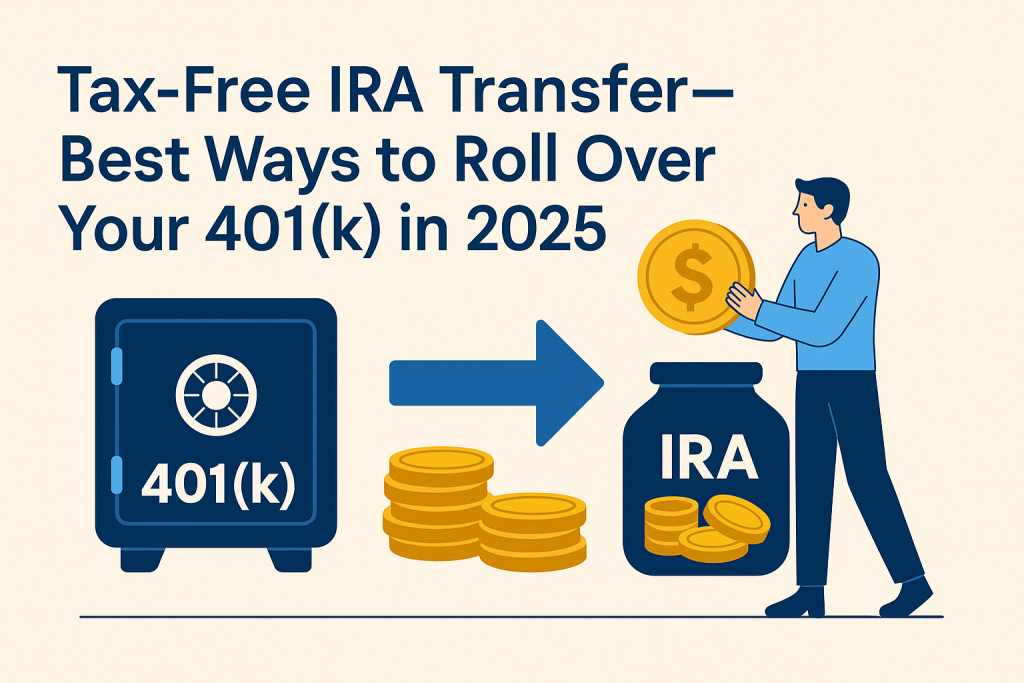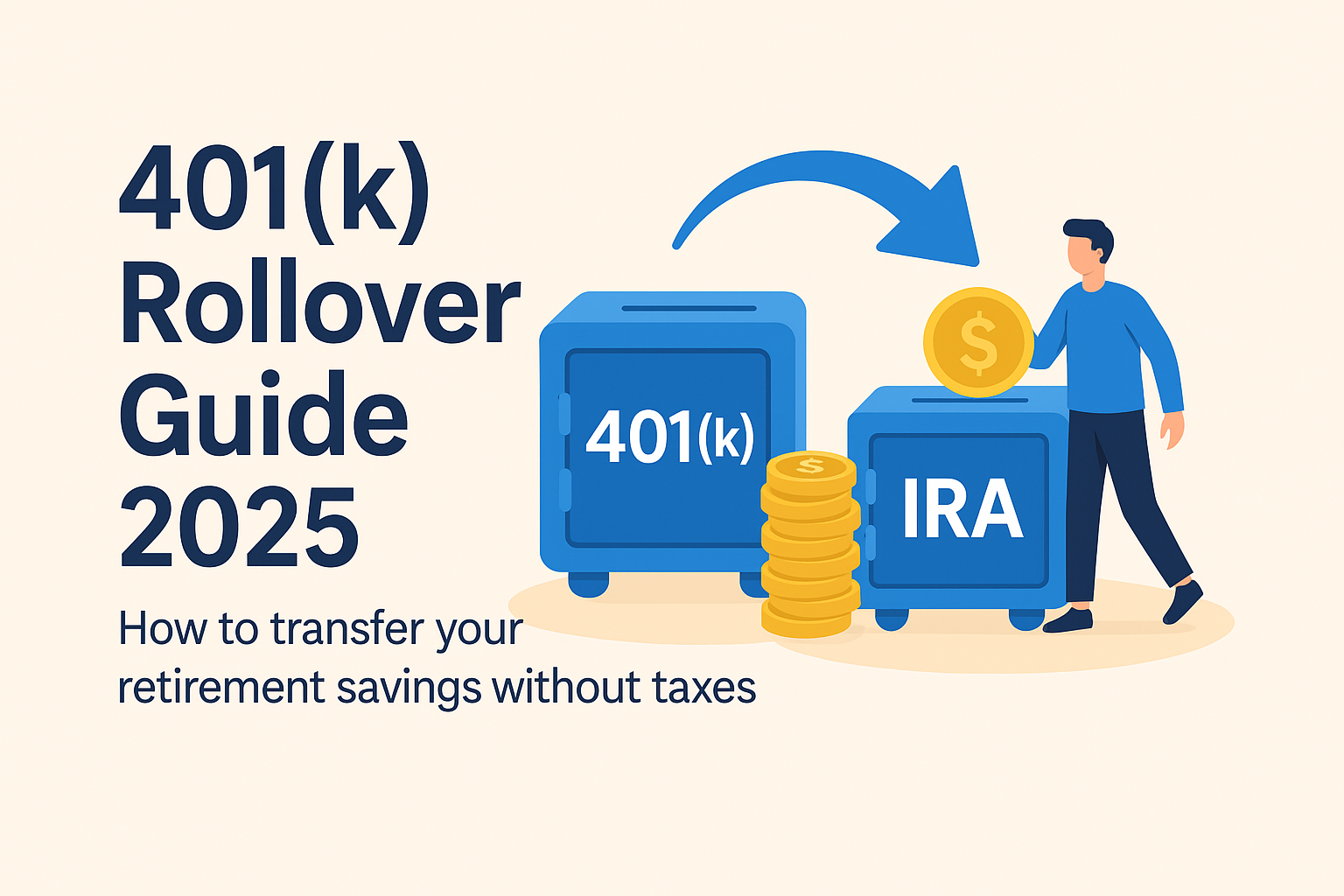Tax-Free IRA Transfer is a crucial strategy for maximizing retirement savings. For many Americans, rolling over their 401(k) to an IRA without paying taxes is a key step in securing their financial future. According to the Investment Company Institute, total U.S. retirement assets reached over $37 trillion in 2024, with 401(k) plans holding $7.5 trillion and IRAs containing $13.9 trillion. Understanding how to transfer funds between these accounts—while avoiding tax penalties—can have a significant impact on long-term financial security.
In this guide, we’ll walk you through the best tax-free strategies for rolling over your 401(k) to an IRA in 2025, covering step-by-step instructions, key rules to follow, and common mistakes to avoid.

What Is a 401(k) Rollover and Why Consider It?
A 401(k) rollover is the process of transferring your retirement savings from an employer-sponsored 401(k) plan to an individual retirement account (IRA) or another eligible retirement account.
Why roll over your 401(k) to an IRA?
✅ More Investment Options – 401(k) plans typically have limited investment choices, while IRAs provide access to a broader range of assets, including stocks, bonds, ETFs, and mutual funds.
✅ Lower Fees – Many employer 401(k) plans charge high administrative fees that can eat into your returns. IRAs often offer lower-cost investment options.
✅ Better Control Over Your Retirement Savings – Once you leave a job, keeping funds in a former employer’s 401(k) may not be ideal. Rolling over to an IRA allows greater flexibility in managing your investments.
✅ Estate Planning Benefits – IRAs provide more estate planning options compared to 401(k)s, such as stretch IRAs for beneficiaries.
🚨 But be careful: If not done correctly, a 401(k) rollover could trigger taxes and penalties, significantly reducing your savings.
Step-by-Step Guide to a Tax-Free 401(k) Rollover
To avoid taxes and penalties, follow these key steps when rolling over your 401(k) to an IRA:
1. Choose the Right Type of IRA
You have two main IRA options:
🔹 Traditional IRA – Best if you want to defer taxes until retirement. Your funds continue to grow tax-deferred, and you’ll only pay taxes when withdrawing in retirement.
🔹 Roth IRA – Suitable if you expect to be in a higher tax bracket in the future. You pay taxes upfront, but withdrawals in retirement are tax-free.
Tip: A direct rollover to a Traditional IRA is the best way to avoid immediate taxes.
2. Request a Direct Rollover (Not an Indirect Rollover!)
🔹 Direct Rollover (Recommended) ✅ – Your 401(k) provider sends the funds directly to your IRA. No taxes are withheld, and you avoid penalties.
🔹 Indirect Rollover (Risky) ❌ – The 401(k) provider sends the check to you, and you must deposit it into an IRA within 60 days. If not, you face:
- 20% mandatory withholding tax
- Early withdrawal penalties if under age 59½
3. Open an IRA Account (If You Don’t Have One Yet)
If you don’t already have an IRA, you’ll need to open one. Top brokerage firms include:
4. Verify the Transfer and Reinvest Your Funds
Once the rollover is complete:
✅ Confirm your 401(k) balance arrived in the IRA
✅ Choose investment options based on your risk tolerance and retirement goals
✅ Monitor performance and adjust as needed
Common Mistakes to Avoid When Rolling Over a 401(k)
🚨 Mistake #1: Taking a Cash Distribution Instead of a Rollover
If you withdraw the funds instead of rolling them over, you could face income taxes + 10% penalty (if under 59½).
🚨 Mistake #2: Not Completing the Rollover Within 60 Days
If you choose an indirect rollover, you MUST deposit funds into the IRA within 60 days or face penalties.
🚨 Mistake #3: Forgetting Required Minimum Distributions (RMDs)
If you’re over 73, you must take Required Minimum Distributions (RMDs) from your IRA.
🚨 Mistake #4: Rolling Over a Traditional 401(k) to a Roth IRA Without Tax Planning
A Roth conversion triggers taxes immediately, so consult a financial advisor before proceeding.
Frequently Asked Questions (FAQs)
❓ Can I roll over my 401(k) if I’m still employed?
✅ Some plans allow in-service rollovers, but rules vary. Check with your employer.
❓ How long does a 401(k) rollover take?
✅ Typically 5-10 business days, depending on your provider.
❓ What if I have a 401(k) from multiple jobs?
✅ You can consolidate all 401(k)s into one IRA for easier management.
❓ Is there a limit to how much I can roll over?
✅ No, you can roll over your entire 401(k) balance with no contribution limit.
Final Thoughts: Should You Rollover Your 401(k) to an IRA?
A 401(k) rollover to an IRA can provide greater investment flexibility, lower fees, and better retirement planning options—but it must be done correctly to avoid unnecessary taxes.
Before making a decision:
✅ Consider your tax situation – Traditional vs. Roth IRA
✅ Opt for a Direct Rollover to avoid penalties
✅ Choose a reputable brokerage firm for your IRA
✅ Consult a financial advisor if you’re unsure
By following these steps, you can maximize your retirement savings while avoiding costly mistakes.
📢 Share Your Thoughts!
Rolling over a 401(k) can be a complex decision. Have you gone through this process before? Share your experience in the comments! If you found this guide helpful, please share it with others planning their retirement.







